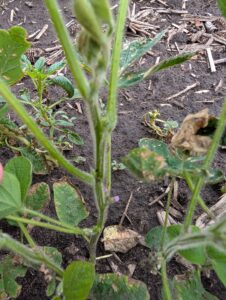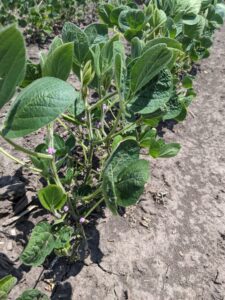Illinois Crop Update – June 27, 2025
Steve Brand – Commercial Agriculture Specialist
DeKalb County
Soil Conditions: Near Normal
Overall, it’s been a very hot and humid week across northern IL as we begin to move out of the heat dome that’s been sitting on us for the past 5 days. This week alone, we have added nearly 200 GDU from the heat wave for Dekalb county with totals reaching 959 GDU on the season, and isolated rainstorms have brought a little bit of relief to the drought-stricken areas. Some fields are still feeling it with pineapple corn, but overall, the corn crop has looked better this past week. With the temperatures expected to remain high as we enter July, I expect any stunting or growth delays from the early season to be grown out of in both corn and soybeans.
Corn has begun to shoot up across most fields I scouted. Lake county still has some shorter corn, but the further west you head on the I-88 corridor, the taller the stands get and that’s reflective of the rain dispersion and late spring cool temps. Corn is between V6/7 and V9/10 depending on planting date and is nearly 5′ high in some fields. Much of the drought stress from last week has been alleviated thanks to some healthy rains this past weekend across Northern IL, as well as some isolated storm systems this week. They are expected to continue, and it would be great if some of the drier fields could catch those stray storms. I have not seen any tar spot or other fungal diseases so far this season, but with the moisture and temperatures rising to the 80s I expect we may see it start to show up in the lower canopy leaves. Fields in western IL have found the disease, and you can track it at the crop protection network website linked below.
https://cropprotectionnetwork.org/maps/tar-spot-of-corn
Soybeans are progressing nicely. On Wednesday 6/25/25 I saw the first field that was producing flowers as we enter the R1 stage for beans. Fields are anywhere from 3rd trifoliate up to R1 flowering based on a number of different environmental factors, as well as planting dates. The further west you push the taller the beans are, with Lake County again showing some shorter beans. Overall, I have not seen any early season diseases, and most damage on the plants is herbicide burn from post applications.
Wheat had a great week of ripening after the cool May and early June. Low disease levels in the fields I scouted and full heads. The grain is still very wet in the head and the plants have some more maturing and drying down to do. If the temperatures hold and stay in the upper 80s, I would expect harvest to begin in some fields around or after the 4th of July.



Emily Hansen – Commercial Agriculture Educator
LaSalle/Putnam County
Soil Conditions: Near Normal
After a very hot and humid last week, LaSalle County received some much-needed rainfall on Tuesday night. Crops were exhibiting quite a bit of heat stress before this but are overall looking much healthier now. There is additional rainfall in the forecast for Wednesday night and potentially into the weekend, but temperatures will be staying in the high 80s-90s. Corn is reaching V6-V7 and most soy is at V2-V3. There is a larger range in growth stages among soy fields, with some being replanted recently. One soy field scouted was at R1. No significant pest or disease problems have been seen yet, but there were Japanese beetles present in many soy fields. Recent reports have indicated that tar spot has been confirmed in Bureau County, so growers should be on the lookout for this disease and continue to scout fields.
Russ Higgins – Commercial Agriculture Educator
Grundy County
Soil Conditions: Mildly Dry (soil is drier than normal, plant growth may have slowed)
A challenge to share soil conditions in northeast Illinois because of isolated pop-up thunderstorms. Some fields received over an inch of rain while many not as fortunate are drying quickly with above average temperatures. I have noted many soy fields exhibiting significant leaf burn from post herbicide applications, likely a combination of tank mix herbicide chemistries, additives and environmental conditions. As our day lengths shorten, we are reminded that in our region we grow indeterminate growth habit soy varieties, which means vegetative growth (additional leaves) continue to be added after the start of reproductive growth (flowering). Despite high temperatures and limited rainfall most corn fields visited have wet leaves early in the morning. Periods of leaf wetness and high relative humidity are contributing risk factors for several corn leaf diseases, including tar spot and gray leaf spot.


Reagan Tibbs – Commercial Agriculture Educator
Logan County
Soil Conditions: Near Normal
The high temperatures over the last week have caused many corn fields to grow at a rapid pace. There is hardly a corn field that is not knee-high, one week before the Fourth of July. At the University Research Plot in Hartsburg, IL, corn is at the V9-V10 stage, with other corn fields in the area in the V7-V8 stage. Soybeans have been facing a tougher challenge with the high temps. While some fields are handling the temperature well, many fields are showing signs of heat stress with cupped leaves. There are not any additional signs of insect or disease pressure yet, but continued high temperatures will likely cause more issues.

Doug Gucker – Local Food Systems and Small Farms Educator
Dewitt, Macon, and Piatt County
Soil Conditions: Near Normal
Currently, the corn and soybean crops are looking good. Soybeans vary from V3 to R2 (full bloom). Corn varies from V7 to R1 (silking), with most of the corn crop V10+ and expecting some in VT before July 4. Weed control is generally looking good.
Alfalfa fields are ready for the second cutting.


Talon Becker – Commercial Agriculture Specialist
Champaign County
Soil Conditions: Near Normal
The heat this week has certainly helped move the crop along in Champaign County. And despite a couple pop-up showers, it has also helped dry out fields enough for post-emergence herbicide applications, which were needed and probably a couple weeks past due in several soybean fields. Soybeans with good early season weed control remain relatively clean. Many soybean fields are starting to flower (R1) or have reached full flower (R2), but there are plenty of later planted fields still in early vegetative growth stages (V2-3).
Early corn is about head high, somewhere around V14-15. Brace roots are just starting to emerge in these fields, which will help in some cases where plants are still leaning from last week’s strong storm. Later corn is generally in the V6-V8 range and starting to grow more rapidly. I passed one wheat field already harvested during my survey and a few others that where fully mature (Feekes 11.4) and not far from harvest themselves.
Although the heat and break from the rain was needed for several farmers to finish up early season field operations, conditions could quickly tip into the dry end with rapidly growing (and transpiring) crops. As always, timely rains will be needed to replenish soil moisture and minimize stress during these hot summer days.



Dane Hunter – Commercial Agricultural Specialist
Marion County
Soil Conditions: Moderately Wet (soil is damp, standing water may be present in low areas, water bodies are full)
The main story in southern Illinois this week has been wheat harvest. Despite many farms still having fields unplanted, or in need of replant, the hot weather has the wheat dry, and combines are rolling. Wheat yields are highly variable this year, largely a result of having 20″+ of rain since March. It seems that fields that are good for wheat and drain well still yielded decently this year. Fields with marginal drainage but that would be OK for wheat in most years, had lots of flooded out spots, which quickly tank field averages. On the bright side, test weights are still coming back good if fungicide was applied. The bad news is that on average yields are about 5-20% lower than last year. Sure, some portions of fields are still hitting 100+bu per acre but also some are coming in at 40bu/ac, 70-85bu/ac averages seem common.
Hot weather is also drying out the ground despite pockets of standing water and spot convective storms. If the weather holds over the next week, double crop beans, and the remaining first crop fields should get planted or replanted.






